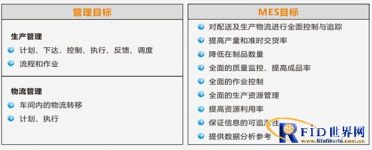
RFID Manufacturing Execution System
[ad_1]
This system mainly passesRFIDTechnology, optimize the management of the entire production process from order placement to product completion. When a real-time event occurs in the factory, MES can respond to it in time, report it, and use the current accurate data to constrain and process them. This rapid response to status changes enables MES to reduce those activities that have no added value within the enterprise, effectively guide the production operation of the factory, and at the same time improve the factory’s ability to deliver in time, improve the circulation performance of materials, and increase the rate of return on production. . MES can also provide mission-critical information about production behavior within the enterprise and throughout the product supply chain through two-way direct communication.
(1) System overview
This system mainly uses RFID technology to optimize the management of the entire production process from order placement to product completion. When a real-time event occurs in the factory, MES can respond to it in time, report it, and use the current accurate data to constrain and process them. This rapid response to status changes enables MES to reduce those activities that have no added value within the enterprise, effectively guide the production operation of the factory, and at the same time improve the factory’s ability to deliver in time, improve the circulation performance of materials, and increase the rate of return on production. . MES can also provide mission-critical information about production behavior within the enterprise and throughout the product supply chain through two-way direct communication.
1. System goals

2. System features
Complete product and process definition
Flexible multi-level process adjustment (products, orders, batches)
Realize comprehensive process control on the workshop site
Provide various control methods (batch level) for the manufacturing process of products
Flexible and integrated data collection methods to adapt to various manufacturing companies
Based on the ISA95 framework, greatly reducing the cost of integration with ERP
Establish a platform based on a unified production model to ensure subsequent scalability and provide a means to continuously increase and adjust production models
Provide a standard external API interface, providing a simple way for users to carry out secondary development
3. Functional characteristics
①Stable and reliable
More than 30,000 hours of continuous operation at the customer site without any software failure
All customers adopt unified basic data
Using offline mode, OLTP can support concurrent processing of large data volumes
②Flexible application
Meet the various needs of manufacturing site management, batch management of work-in-process, process attached to batch, multiple data collection methods, products and processes are fully definable
Meet the various needs of users, support multi-language, user personalized interface, editable vocabulary correspondence, trigger data collection by event, B/S architecture,
Service-oriented system architecture, the system can be expanded and customized development is convenient
③Easy to implement
Standard software has been built, more on-site definition and configuration, less customized development
(5) System design

(6) Demand summary

(7) Business structure

(8) Function module

[ad_2]



